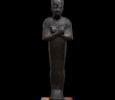Large Bronze Figure of Osiris
A bronze statuette of mummiform Osiris on a wooden base. The god wears the White Crown of Upper Egypt, with a central uraeus and chin strap, which would have originally attached to a false beard (now missing). The facial features are cast in fine detail, with slender eyebrows over recessed almond-shaped eyes with prominent cosmetic lines. The hands are crossed over the chest, and the lower ends of the crook and flail remain below the fists – originally these implements would have extended upwards towards the shoulders. Statuettes such as this were made in a range of sizes, and this is a notably large example. One of similar size is now in The Metropolitan Museum, New York (61.45).
As firstborn child of the earth god Geb and sky goddess Nut, Osiris was one of the oldest gods in the Egyptian pantheon. Myth positioned him as one of the first pharaohs of Egypt, who, along with his consort Isis, taught agriculture and crafts to mankind. After his death at the hands of his brother Seth and subsequent resurrection, Osiris ruled as Lord of the Underworld, god of reincarnation and judge of the dead. He is often depicted in mummified form, holding the royal implements of the crook and flail and wearing the White Crown in reflection of this role. By the first millennium B.C., statues and statuettes of Osiris were offered in temples in great numbers, reflecting his importance. Statues of Osiris have been found in sites identified as temples and shrines dedicated to the god, but others have been found as offerings in contexts which are less clear.
Reputedly from the Great Temple of Osiris at Karnak, according to Blanchard’s Egyptian Museum Certificate of Antiquity and bronze plaque on stand.
Blanchard’s Egyptian Museum, Cairo, from at least c. 1911.
In the Private Collection of Olive Farnworth and her mother, Graiseley Cottage, Wolverhampton, acquired from the above in c. 1911 and kept there until at least 1921, and later moved to Sainsfoins, Little Shelford, Cambridge, as recorded in her house inventory, dated 5th May 1921.
Thence by descent.
ALR: S00237433, with IADAA Certificate, this item has been checked against the Interpol database.
Ralph Huntington Blanchard (1875-1936) was an American antiquities dealer in Cairo, Egypt. Born in Fulton, NY on 25 June 1875, he was the son of Seymour Bailey and Anna Louise Franklin. He came to Egypt in 1905 and worked in the American Consular Service until 1910. He later became a ‘top tier’ antiquities dealer with a formal licence to sell ancient artefacts, with his shop located next to the entrance of the famous old Shepheard’s Hotel. In addition to his stock, he had a large private collection of scarabs, some of which were published by Newberry, A Handbook of Egyptian Gods and Mummy-amulets (Cairo, 1909). His collection was dispersed after his death in 1936, with many being acquired by dealers Matouk and Michailides.











 Enquire
Enquire




